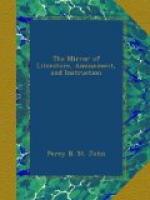Melrose Abbey was founded by king David of Scotland in 1136. It is supposed to have been built in ten years. The church of the convent was dedicated to St. Mary on the 28th of July, 1146. It was the mother church of the Cistertian order in Scotland. The monks were brought from Rievaulx Abbey, in Yorkshire. Their habit was white; and they soon superseded the order of the Benedictines.
The abbey is built in the form of St. John’s cross, of the Gothic style of architecture, and is 258 feet in length; the breadth 137-1/2 feet; and 943 feet in circumference. A considerable part of the principal tower is now in ruins; its present height is 84 feet. There are many very superb windows; the principal one at the east end (which is the top nave of the cross,) appears to have been more recently built than the others, and is 57 feet in extreme height, and 28 feet wide. It has been ornamented with statues, &c. The beauty of the carved work, with which the abbey is profusely decorated, is seldom equalled, and deservedly celebrated:
“Spreading herbs and flow’rets
bright,
Glisten’d with the dew of night;
Nor herb nor flow’ret glisten’d
there,
But was carved in the cloister’d
arches as fair.”
There are in the external view of the building 50 windows, 4 doors, 54 niches, and above 50 buttresses. The abbey was much injured by the English in 1322 and 1384. Richard II. made it a grant in 1389, as some compensation for the injuries it had sustained in the retreat of his army. It was also greatly defaced during the reformation. A stronger proof of their infatuated and (partly) misplaced zeal cannot be adduced, than the destruction of religious edifices by the reformers. There were one hundred monks, without including the abbot and dignitaries. The last abbot was James Stuart, natural son of James V., who died in 1559. The privileges and possessions of the abbey were very extensive,.and it was endowed by its founder, David, with the lands of Melrose, Eildon, &c., &c., right of fishery on the Tweed, &c.; and succeeding monarchs increased its property. Sixty of the monks, it is said, renounced popery at the reformation. In 1542, the revenue of the abbey was, “1758_l_. in money, 14 chalders nine bolls of wheat, 56 chal. 5 bolls of barley, 78 chal. 13 bolls of meal, 44 chal. 10 bolls of oats, 84 capons, 620 poultry, 105 stone of butter, 8 chal. of salt, 340 loads of peats, and 500 carriages;” besides 60 bolls of corn, 300 barrels of ale, and 18 hogsheads of wine, for the service of the mass: a large quantity for the entertainment of strangers; 4,000_l_. for the care of the sick; and 400_l_. to the barber. These were given up at the commencement of the reformation in 1561. The lands were either seized by the crown, or divided amongst the nobles. A large portion fell into the hands of the Buccleugh family.




